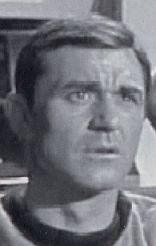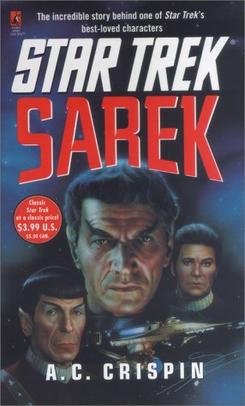
The Romulans are an extraterrestrial race in the American science fiction franchise Star Trek. They first appeared in the series Star Trek (1966–1969). They have appeared in most subsequent Star Trek releases, including The Animated Series, The Next Generation, Deep Space Nine, Voyager, Enterprise, Discovery, Picard, Strange New Worlds, and Lower Decks. They appear in the Star Trek feature films Star Trek V: The Final Frontier (1989), Star Trek VI: The Undiscovered Country (1991), Star Trek: Nemesis (2002) and Star Trek (2009). They also appear in various other spin-off media, including books, comics, toys and games.
The Star Trek fictional universe contains a variety of weapons, ranging from missiles to melee. The Star Trek franchise consists mainly of several multi-season television shows and a dozen movies, as well as various video games and inspired merchandise. Many aspects of the Star Trek universe impact modern popular culture, especially its fictitious terminology and the concept of weaponry on spacecraft. The franchise has had a widespread influence on its audiences from the late 20th to early 21st century. Notably, Star Trek's science fiction concepts have been studied by real scientists; NASA described it in relation to the real world as "entertaining combination of real science, imaginary science gathered from lots of earlier stories, and stuff the writers make up week-by-week to give each new episode novelty." For example, NASA noted that the Star Trek "phasers" were a fictional extrapolation of real-life lasers, and compared them to real-life microwave based weapons that have a stunning effect.

Vulcans, sometimes referred to as Vulcanians, are a fictional extraterrestrial humanoid species in the Star Trek universe and media franchise. In the various Star Trek television series and films, they are noted for their attempt to live by logic and reason with as little interference from emotion as possible. Known for their pronounced eyebrows and pointed ears, they originate from the fictional planet Vulcan. In the Star Trek universe, they were the first extraterrestrial species to make contact with humans.

Star Trek III: The Search for Spock is a 1984 American science fiction film, written and produced by Harve Bennett, directed by Leonard Nimoy, and based on the television series Star Trek. It is the third film in the Star Trek franchise and is the second part of a three-film story arc that begins with Star Trek II: The Wrath of Khan (1982) and concludes with Star Trek IV: The Voyage Home (1986). After the death of Spock (Nimoy), the crew of the USS Enterprise return to Earth. When James T. Kirk learns that Spock's spirit, or katra, is held in the mind of Dr. Leonard "Bones" McCoy, Kirk and company steal the decommissioned USS Enterprise to return Spock's body to his homeworld. The crew must also contend with hostile Klingons, led by Kruge, who are bent on stealing the secrets of the powerful terraforming device, Genesis.
"Mirror, Mirror" is the fourth episode of the second season of the American science fiction television series Star Trek. Written by Jerome Bixby and directed by Marc Daniels, it was first broadcast on October 6, 1967.

"Balance of Terror" is the fourteenth episode of the first season of the American science fiction television series Star Trek. Written by Paul Schneider and directed by Vincent McEveety, it first aired on December 15, 1966.
"Errand of Mercy" is the twenty-sixth episode of the first season of the American science fiction television series Star Trek. Written by Gene L. Coon and directed by John Newland, it was first broadcast on March 23, 1967. It was the first episode in which the Klingons appeared.

"Amok Time" is the second season premiere episode of the American science fiction television series Star Trek. Written by science fiction author Theodore Sturgeon, scored by Gerald Fried, and directed by Joseph Pevney, it first aired on September 15, 1967.

"Journey to Babel" is the tenth episode of the second season of the American science fiction television series Star Trek. Written by D. C. Fontana and directed by Joseph Pevney, it was first broadcast on November 17, 1967.

"Unification" is a two-part episode of the syndicated American science fiction television series Star Trek: The Next Generation which features Leonard Nimoy as Spock. The first of the two episodes earned a 15.4 household Nielsen rating, drawing over 25 million viewers, making it one of the most watched episodes in all seven seasons of The Next Generation's run.
This article discusses the fictional timeline of the Star Trek franchise. The franchise is primarily set in the future, ranging from the mid-22nd century to the late 24th century, with the third season of Star Trek: Discovery jumping forward to the 32nd century. However the franchise has also outlined a fictional future history of Earth prior to this, and, primarily through time travel plots, explored both past and further-future settings.
"More Tribbles, More Troubles" is the fifth episode of the first season of the animated American science fiction television series Star Trek. It first aired in the NBC Saturday morning lineup on October 6, 1973, and was written by David Gerrold as a sequel to his Original Series episode "The Trouble with Tribbles". It features actor Stanley Adams reprising his role of trader Cyrano Jones, and the return of the fuzzy, rapidly reproducing creatures called tribbles.
"The Deadly Years" is the twelfth episode of the second season of the American science fiction television series Star Trek. Written by David P. Harmon and directed by Joseph Pevney, it was first broadcast December 8, 1967.
"Elaan of Troyius" is the thirteenth episode of the third season of the American science fiction television series Star Trek. Written and directed by John Meredyth Lucas, it was first broadcast on December 20, 1968.

General Chang is a fictional character from the Star Trek fictional universe, portrayed by Christopher Plummer as the central antagonist in Star Trek VI: The Undiscovered Country, a feature film released in 1991.
"Day of the Dove" is the seventh episode of the third season of the American science fiction television series Star Trek. Written by Jerome Bixby and directed by Marvin Chomsky, it was first broadcast November 1, 1968.

Star Trek: Sarek is a novel by A. C. Crispin, set in the fictional Star Trek universe. It is set shortly after the motion picture Star Trek VI: The Undiscovered Country. Ambassador Sarek of Vulcan discovers evidence of a complicated plot to cripple the United Federation of Planets; he must work to find out who is behind it while also coming to terms with the death of his human wife, Amanda Grayson. A secondary storyline follows the adventures of Peter Kirk, nephew of James T. Kirk, who inadvertently becomes caught up in the enemy's schemes.

Yesterday's Son is a science fiction novel by American writer A. C. Crispin set in the fictional Star Trek Universe. It describes the events surrounding Spock's discovery that he has a son. Yesterday's Son and its sequel, Time for Yesterday, make up A. C. Crispin's "Yesterday Saga".

Star Trek: Secret of Vulcan Fury is a cancelled action-adventure game, in development by Interplay Entertainment from 1997 until its cancellation in 1999. Based on the Star Trek: The Original Series license, the game would have followed Captain James T. Kirk and the crew of the USS Enterprise through a series of adventures regarding the Vulcan and Romulan races. Secret of Vulcan Fury was to have been the latest in a series of games produced by Interplay based on the license. It would have featured a control method similar to those seen in LucasArts games of that period, and nearly seven hours of full motion video capture using clay models.
The following outline is provided as an overview of and topical guide to Star Trek:








